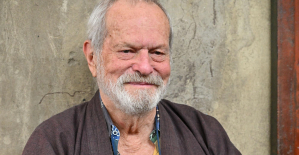Demonstrations, clashes and arrests began in mid-August "when the authorities gave four days to the inhabitants of areas pre-empted by the government to leave", told AFP a fifty-year-old resident wishing to remain anonymous.
On this island north of Cairo, in a bend of the Nile, 100,000 Egyptians live in ocher brick houses between green fields, irrigation canals and livestock. Every day, by the thousands, they go to work by ferry in the other districts of Cairo.
For the Minister of Housing Assem el-Gazzar, these accommodations are "unsanitary". And those who contest are "forces of evil" who "systematically oppose development projects".
Already in 2017, clashes between residents and security forces left one dead.
At the time, the government accused the residents of having "illegally for more than 15 years" built houses on agricultural land.
False, then replied the lawyer Khaled Ali by sharing on Facebook property deeds as well as the birth certificate of a resident born on the island "100 years ago".
- "It's not Manhattan" -
Two years later, the administrative justice decided, justifying the expulsions by "the public interest".
The 50-year-old father, self-employed in the agricultural sector, says he is ready to leave, but not at any price.
"We are offered 70 euros per m2, but with that, we can't buy anything off the island," he laments, even though Cairo keeps saying that redeveloping Warraq can pay off big.
Already, former President Hosni Mubarak, overthrown in 2011 by the street, wanted to transform the largest island of the capital - six km2 - into a business district.
The current president, Abdel Fattah al-Sissi, a former marshal, reactivated this plan and entrusted it to military engineers.
"It's not Manhattan but Warraq", boasted the government when it published plans for "Horus City", named after the ancient Egyptian sun god, at the end of July.
Glittering skyscrapers, heliports and marinas will cohabit with green spaces for nearly a billion euros.
The inhabitants could find their place there, assures AFP another resident, in his thirties, who also refuses to give his name.
"We only want 1.26 km2 to be left to the inhabitants - even behind a wall", he pleads.
And if the state refuses, "we will not leave", he threatens, ensuring that he has all the documents proving that he is legally occupying the premises. "We pay our taxes, water and electricity, why couldn't we benefit from the development of our island?"
Beyond Warraq, other islands fear the same fate, such as Dahab, further south.
This year, 17 of them, including Warraq, lost their status as nature reserves after being handed over to the army.
- "Empty the poor" -
But opposing the remodeling of Cairo can be expensive: in 2019, activist Ramy Kamel was detained for more than two years for "terrorism", because he "denounced forced displacements of Christians, in particular in Warraq", historian Amy Fallas told AFP.
If the more affluent neighborhoods are not spared by the policy of the bulldozer, the disadvantaged informal sectors are the first targets, assures the urban planner Ahmed Zaazaa.
The government wants to "completely empty the heart of the capital of the poor", he told AFP, in a country where two thirds of the inhabitants live around the poverty line.
For the town planner, the State seeks "to provide for the needs of the new capital" which is being built 50 kilometers away.
According to him, "in order for the workforce to have access to it, (the State) builds social housing and transport axes which modify the geography of Cairo" and "destroy the historic districts of the center" and their social fabric. .
In Warraq too, residents say they fear finding themselves uprooted and isolated in neighborhoods where the solidarity between neighbors that currently allows them to survive will have disappeared.
Since Mr. Sissi took power in 2013, Mr. Zaazaa has compiled official reports, press clippings and satellite images.
According to him, around "15,000 buildings have been demolished in Cairo" -- a huge number because "Beirut, for example, has 18,000 buildings".
In Warraq, "non-residents cannot enter", explains the thirty-something resident.
And the experts are reduced to consulting satellite images to see the progress of the destruction.

 United States: divided on the question of presidential immunity, the Supreme Court offers respite to Trump
United States: divided on the question of presidential immunity, the Supreme Court offers respite to Trump Maurizio Molinari: “the Scurati affair, a European injury”
Maurizio Molinari: “the Scurati affair, a European injury” Hamas-Israel war: US begins construction of pier in Gaza
Hamas-Israel war: US begins construction of pier in Gaza Israel prepares to attack Rafah
Israel prepares to attack Rafah First three cases of “native” cholera confirmed in Mayotte
First three cases of “native” cholera confirmed in Mayotte Meningitis: compulsory vaccination for babies will be extended in 2025
Meningitis: compulsory vaccination for babies will be extended in 2025 Spain is the country in the European Union with the most overqualified workers for their jobs
Spain is the country in the European Union with the most overqualified workers for their jobs Parvovirus alert, the “fifth disease” of children which has already caused the death of five babies in 2024
Parvovirus alert, the “fifth disease” of children which has already caused the death of five babies in 2024 Falling wings of the Moulin Rouge: who will pay for the repairs?
Falling wings of the Moulin Rouge: who will pay for the repairs? “You don’t sell a company like that”: Roland Lescure “annoyed” by the prospect of a sale of Biogaran
“You don’t sell a company like that”: Roland Lescure “annoyed” by the prospect of a sale of Biogaran Insults, threats of suicide, violence... Attacks by France Travail agents will continue to soar in 2023
Insults, threats of suicide, violence... Attacks by France Travail agents will continue to soar in 2023 TotalEnergies boss plans primary listing in New York
TotalEnergies boss plans primary listing in New York La Pléiade arrives... in Pléiade
La Pléiade arrives... in Pléiade In Japan, an animation studio bets on its creators suffering from autism spectrum disorders
In Japan, an animation studio bets on its creators suffering from autism spectrum disorders Terry Gilliam, hero of the Annecy Festival, with Vice-Versa 2 and Garfield
Terry Gilliam, hero of the Annecy Festival, with Vice-Versa 2 and Garfield François Hollande, Stéphane Bern and Amélie Nothomb, heroes of one evening on the beach of the Cannes Film Festival
François Hollande, Stéphane Bern and Amélie Nothomb, heroes of one evening on the beach of the Cannes Film Festival Skoda Kodiaq 2024: a 'beast' plug-in hybrid SUV
Skoda Kodiaq 2024: a 'beast' plug-in hybrid SUV Tesla launches a new Model Y with 600 km of autonomy at a "more accessible price"
Tesla launches a new Model Y with 600 km of autonomy at a "more accessible price" The 10 best-selling cars in March 2024 in Spain: sales fall due to Easter
The 10 best-selling cars in March 2024 in Spain: sales fall due to Easter A private jet company buys more than 100 flying cars
A private jet company buys more than 100 flying cars This is how housing prices have changed in Spain in the last decade
This is how housing prices have changed in Spain in the last decade The home mortgage firm drops 10% in January and interest soars to 3.46%
The home mortgage firm drops 10% in January and interest soars to 3.46% The jewel of the Rocío de Nagüeles urbanization: a dream villa in Marbella
The jewel of the Rocío de Nagüeles urbanization: a dream villa in Marbella Rental prices grow by 7.3% in February: where does it go up and where does it go down?
Rental prices grow by 7.3% in February: where does it go up and where does it go down? Even on a mission for NATO, the Charles-de-Gaulle remains under French control, Lecornu responds to Mélenchon
Even on a mission for NATO, the Charles-de-Gaulle remains under French control, Lecornu responds to Mélenchon “Deadly Europe”, “economic decline”, immigration… What to remember from Emmanuel Macron’s speech at the Sorbonne
“Deadly Europe”, “economic decline”, immigration… What to remember from Emmanuel Macron’s speech at the Sorbonne Sale of Biogaran: The Republicans write to Emmanuel Macron
Sale of Biogaran: The Republicans write to Emmanuel Macron Europeans: “All those who claim that we don’t need Europe are liars”, criticizes Bayrou
Europeans: “All those who claim that we don’t need Europe are liars”, criticizes Bayrou These French cities that will boycott the World Cup in Qatar
These French cities that will boycott the World Cup in Qatar Medicine, family of athletes, New Zealand…, discovering Manae Feleu, the captain of the Bleues
Medicine, family of athletes, New Zealand…, discovering Manae Feleu, the captain of the Bleues Football: OM wants to extend Leonardo Balerdi
Football: OM wants to extend Leonardo Balerdi Six Nations F: France-England shatters the attendance record for women’s rugby in France
Six Nations F: France-England shatters the attendance record for women’s rugby in France Judo: eliminated in the 2nd round of the European Championships, Alpha Djalo in full doubt
Judo: eliminated in the 2nd round of the European Championships, Alpha Djalo in full doubt


















